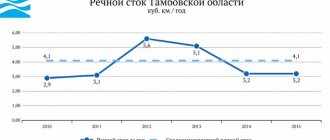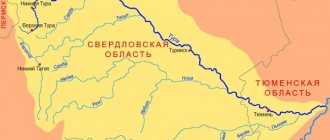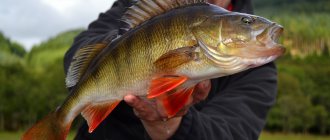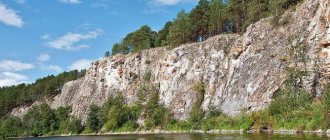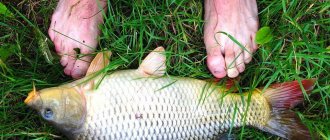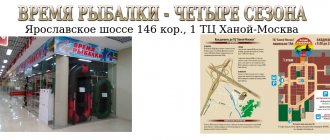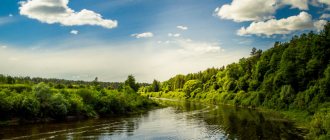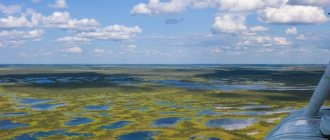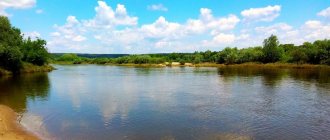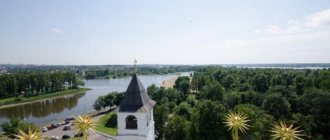Team Nomads
Dubna is a river in the Vladimir and Moscow regions of the Russian Federation, a right tributary of the Volga . Dubna originates in the Vladimir region, between the villages of Korely and Zezevitovo, near the city of Aleksandrov, on the slopes of the Klinsko-Dmitrovskaya ridge. The river flows into the Volga east of the city of Dubna, 8 km below the Ivankovskaya dam.
On Dubna there is the city of the same name, the village of Verbilki, the villages of Brykovy Gory, Berezino, the villages of Ratkovo, Mukhanovo. Length - 167 km, basin area - 5350 km².
SPRINGS OF THE MOSCOW REGION - HERE!
ARTICLE ABOUT THE CITY OF MOSCOW - HERE!
ATTRACTIONS OF THE MOSCOW REGION - HERE!
ANOMALOUS ZONES AND PLACES OF POWER IN THE MOSCOW REGION - HERE!
TREASURES OF THE MOSCOW REGION - HERE!
RIVERS OF THE MOSCOW REGION - HERE!
NATURAL MONUMENTS OF THE MOSCOW REGION - HERE!
flood on the Dubna River
The Dubna initially flows mainly to the west. In the Moscow region, near the village of Filisovo, it turns north, and after merging with Sulaty, it turns southwest. 6 km above Verbilok changes its general direction to the north-west. In the middle reaches there are long straightened sections. The banks are predominantly low-lying and marshy. It is navigable for 15 km from the village of Berezhok to the mouth.
Main tributaries: left - Kunya, Kubzha, Velya, Sestra River (largest) , Rassolovka; right - Sulat.
Water register data According to the state water register of Russia, it belongs to the Upper Volga Basin District , the water management section of the river is the Volga from the Ivankovo hydroelectric complex to the Uglich hydroelectric complex (Uglich reservoir), the river sub-basin of the river is the basins of tributaries of the (Upper) Volga to the Rybinsk reservoir. The river basin is the (Upper) Volga to the Kuibyshev reservoir (without the Oka basin)[2]. According to the geoinformation system for water management zoning of the territory of the Russian Federation, prepared by the Federal Agency for Water Resources[2]: Water body code in the state water register - 08010100812110000003066 Hydrological knowledge code (HI) - 110000306 Basin code - 01/08/01/008 Volume number on GI - 10 Issue on GI - 0 Dubna River
Rivers flow in (km from the mouth) 11 km: Sestra River (l) 26 km: streams creek. Kuiminka (n) 27 km: Kunovka river (l) 60 km: Yakot river (l) 61 km: Shibovka river (l) 63 km: Velya river (l) 74 km: Shibakhta river (l) 78 km: Koreshovka river (l) k) 82 km: watercourse ditch Nushpolka (p) 93 km: river Kobzha (Kubzha) (l) 105 km: river Sulat (Sulot) (p) 112 km: river without a name, 2 km southwest from the village. Bolebotino (p) 113 km: Vytravka River (l) 120 km: Gusarenka (Peremoika) River (l) 130 km: Kunya River (l) 144 km: Rassolovka River (l) Dubna River
LOITATION ON THE DUBNA RIVER
The Dubna, a right tributary of the Volga , flows through the territories of the Vladimir and Moscow regions. It originates from the springs on the eastern outskirts of the Klinsko-Dmitrovskaya Upland (sheet 14) and flows into the Volga near the city of Dubna at a level of 113 m. You can get to the river from Aleksandrov, Segiev Posad or Zagorsk. Its length is 167 kilometers, the basin area is 5350 square kilometers. Over the first twenty-five kilometers to the border of the Moscow region, its bed is literally cut up by rivers and streams that feed its waters. On the territory of the Moscow region on the flat plains of the Upper Volga Lowland, the nature of its movement changes. It slows down its flow as it approaches the north, directing the waters to the Dubninskaya lowland, where the Sulot River flows into it and connects with a whole chain of lakes. The largest of them is Zabolotskoye, famous for the fact that several years ago an extremely rare algae, Cladophora, a “precious relic of the Ice Age”, similar to large velvet green balls, was found there several years ago. The lake and river Sulot were poetically described by Prishvin in the story “Crane Joy”. Below Dubna turns sharply to the left - the Taldom moraine ridge blocks its road. Then it flows west along the Dubninskaya lowland. Its right bank is steeper, hilly, gully, with springs and springs, the left bank is flat, due to the proximity of the Upper Volga Plain. The Dubninskaya lowland is almost completely covered with swamps, which are home to many cranes and other birds. After the glacier left, a chain of lakes remained here, which were covered and overgrown. There are a lot of cranberries in the swamps. The river floodplain here is wide and flat. The Dubna flows quietly and calmly, in the spring it overflows for several kilometers and in the summer it does not return to its channel for a long time. Impenetrable thickets of bushes and willows hang over the wide pools, behind them there are moss-covered hummocks, swamps and swamps with low-growing birch forests, green succulent sedge, and further - impenetrable alder swamps. Forests and swamps near Dubna are a favorite place for hunters. Ducks, snipe, and wood grouse live in the reeds and sedges.
The Dubninskaya lowland is now crossed by artificial canals. The channels of the Dubna and its tributaries have been straightened. Artificial embankments strengthen the banks and protect them from floods, and many swamps have turned into water meadows. Near the town of Nushpola, Dubna turns south and then southwest, its valley narrows, the depth reaches about three meters. From the Klinsko-Dmitrovskaya ridge, its left tributary, the winding Velya River, carries water towards Dubna. After merging with Velya, the Dubna valley becomes less swampy. Sandy banks rise along the riverbed, surrounded by willow trees. Water often floods them in spring. Water meadows alternate with overgrown swamps. The river meanders strongly, and after each flood in some sections it even changes its course. Spring waters destroy steep banks.
The Dubna Valley from the mouth of the Veli River to the village of Verbilki is a rich corner of nature. Forests occupy up to 80% of the land area. The sands form ridges up to four meters high. Rare plants for these places grow on the sandy soil: hairy hawkweed with a yellow flower rising from a rosette of leaves, sand violet with dull greenery covered with short fluff, graceful cat's paw, heather, and, clinging to the ground, gray-green, like lichens dusted with frost, spread . On the sands, among the lilac heather, there are rare low-growing branchy pines, spreading and powerful in appearance, like heroes, and in the wetter areas - in the light pine forests that reach into the heights - there are thickets of lingonberries, lilies of the valley and other herbs and shrubs. In slightly lower areas, mixed forest predominates. In it, pine is adjacent to spruce and birch, and there are islands of green moss - it is called cuckoo flax. In areas that are swampy or flooded in spring, there are gray alder, birch and willow. Along the drainage canals and ditches, raspberries, black currants, bird cherry, and hops grow in abundance. The hummocks overgrown with sedge reach one meter in height; small trees grow on them, as well as nettles, meadowsweet and other tall grasses. The forests contain a number of plants that are found only in the northern regions of the Moscow region: Lapland willow, club moss, northern linnaea. The fauna of these places is also very rich. On the wide terrace there are several extensive swamps - remnants of ancient lake basins. In one of them, among thickets of black alder, there is the blind mouth of the Shibovka River. It spills over the swamp and does not flow further, freezes, down, a small stream flows into Dubna. In the southern reaches of the river between its left tributaries: Yakot and Vetelka, there is another, the so-called “White Swamp”. It was drained and now an area of 12 square kilometers is occupied by a birch and willow forest. The surface of the swamp is overgrown with grasses, under them there is a peat bog, under the peat bog there is a thick layer of sand, and under the sand there is a moraine. On the southern edge of the swamp, bluish-gray lacustrine clays were found under a layer of peat, confirming that there had once been a lake here.
basin of the Volga and tributaries of the Dubna River
The Dubna floodplain as a whole covers an area of up to 50 thousand hectares and suffers from excess water. But the soil along the river is fertile. There are many peat bogs here; the peat reserves of the Dubninskaya lowland are estimated at 500 million tons. Woody and sedge peat is rich in valuable organic and mineral substances - in itself, without any pre-treatment, it is a most valuable fertilizer and quite suitable fuel. From the “White Swamp” the Dubna turns northwest and flows along the Upper Volga Lowland to the Volga. Its width in the lower reaches reaches 40 meters, depth - 3 meters. the largest tributary, the Sestra River, flows into it, Dubna becomes high-water and full-flowing, taking on a “second birth.” It flows into the Volga in the Tver region, eight kilometers from the Ivankovo dam.
Dubna River
Dubna is the right, largest tributary of the Volga in the region. The river is quite unique, flowing through a long swampy lowland. The most attractive place for traveling is Dubna in its lower reaches after the town of Verbilka, from the station where it is about 500-600 m to the river. The river at the beginning flows in high banks, the river valley is relatively narrow and covered with small copses and groves. The forest is predominantly deciduous and mixed. Then the valley expands, the forest is replaced by meadows and moves away from the river. The river is not wide, of medium sinuosity, shallow; There are shallows, and in some places there are thick thickets of reeds, sedges, and water lilies. In the riverbed there are islands overgrown with willow trees, which, alas, are not suitable for parking. The water is clean. The river speed is about 1 km/h (swamp). Dubna River
From Moscow you can take a train to the city of Zagorsk, from where you can take a bus to the village of Konstantinovo. There, on the road to Mergusovo, exactly two kilometers from the village, there is a bridge over the Dubna River. There is a dam under the bridge where you can swim. The river is still very narrow (about 3 meters wide). The banks are initially steep, high and marshy. At first the river wags strongly, then a straight channel begins. There are swamps along the banks of the river. The swamps stretch for a very long time; there is not a single suitable place to spend the night. In the area of the villages of Zamostye and Skovorodino you can spend the night on the right bank. There is no swamp, but there is a steep and muddy bank, dry at the top, but with tall grass. After a few kilometers there is a small dam. The river is just as narrow. After the bridge, along which the road goes from Trans-Kubezhye to the village of Ostrov, the vegetation is more diverse, birch trees appear, the banks become low. Then the river begins to more or less meander. Further on, the river is wide and the bottom is sandy, there are many places where it is good to swim. Behind the village of Starkovo there is a very high left bank, the place is very beautiful. Soon the mouth of the Velya River. Velya is twice as narrow as Dubna. From the Velya River to the village of Verbilki the river is terribly winding. The river is not visible further than 200 meters. There is a blockage under the bridge in front of Verbilki. Next, you need to be careful about places to spend the night, because... the good ones are often busy. Beyond the railway bridge the river is already very wide, there are many islands, and the depth is shallow. Behind the village of Nikulki there are marshy shores. Behind the highway bridge are the villages of Bolshoye Yudino and Maloye Yudino. Further to the Volga along the way there are a huge number of villages and dachas, the river is shallow.
There is a road along the left bank of the river, almost the entire length, but it is not visible from the water, so it creates a feeling of remoteness from civilization. The population is average; on weekends and holidays there are many vacationers and fishermen. There are enough parking places, there are no problems with firewood (there is a lot of dry wood).
BRIEF REPORT ON RAFTING ON THE DUBNA RIVER Down the Dubna River
Our hike began at Verbilki. We set up a tent next to the zoo on the banks of the Dubna River. In the evening we assembled the kayak. In the morning after breakfast at 9.26 we started rafting. We passed the following settlements:
1. Novonikolskoye - 9.40 (4.5 km) 2. Glinka - 9.50 (6 km) 3. Votrya - 10.06 (7 km) 4. Tarusovo - 10.32 (10 km) 5. Trinity-Vyazniki 11 hours. (11 km)
We stopped here for an excursion to the temple. We hit the road at 12.00
6. Korishovo 12.16 (13 km) 7. Popadyino 12.40 8. Strashevo 12.55 9. Most 13.24 10. Yudino 13.26 (24.5 km) 11. Panovka 13.31 12. Zhukovo (dachas) 13.36 (26 km) 13. Nagovitsino 13.47 14. Krivets 13.51 15. Gusenki 14.01 16. Kutachi 14.18 17. Starikovo 14.51 (33.5 km)
Here we stopped for lunch. We hit the road at 15.45
18. Berezhok 15.50 (34 km) 19. Veretyevo 16.00 20. Filippovo and power lines 16.04 (37 km) 21. Mouth of Strelka 16.33 (39.2 km) 22. Mouth of the Sestra River 16.38 23. Yurkino 16.44 24. SKS 17.00 25. Bridge 17.14 (46 km)
BERTH 17.21
mouth of the Dubna River
FISHING ON THE DUBNA RIVER Fishing report: October 07, 2014, Dubna, river Place - region/district: Moscow and Moscow region. Detailed description of the place: Dubna River in the TsKS area Weather, condition of the reservoir: +4, calm, water temperature +6, cloudy, no rain. Fishing method: Spinning My lures: Jig 6-8g with various rubber options What fish did I catch: pike My catch: 1-3 kilograms The largest fish is pike, 600 gr. Detailed fishing report My friend and I arrived at the pond while it was still dark, namely at 7:30, by the time we collected our gear it was already dawn. We decided right away, without warming up on the perch, to find a pike, after about 10 casts I felt a poke, a hook and a palm-sized perch landed on a fairly large edible rubber, after a couple of minutes there was another bite, but it didn’t register (since we were still targeting to catch pike, we did not reduce the size of the tires. In this regard, perch was sometimes still caught. After an hour of fishing, a boat came out from around the bend - a man was checking the net. Then we realized that there was nothing special for us in this place and decided to move 1 km up the river. (Unfortunately, it should be noted that nets in this section of the river are set constantly and everywhere (( ) By the way, a man took a couple of good asps and ides from the nets, there was also a pike 2 kg. Having moved, we also saw boat removing the net, we cursed a little, but I found a more or less interesting place, and on the second cast I pulled out half a kilo of string. This ended our fishing, because we had to go to work. Dubna River
Fishing report: July 7, 2014 - July 7, 2014, Dubna, river Place - region/district: Moscow and Moscow region. Detailed description of the place: Verbilki station. Walk along the rails to the railway bridge. From the railway bridge downstream. Weather, condition of the reservoir: Air temperature 17-23, clear water, no wind Fishing method: Spinning My tackle: Black hole bassmania rod 4.5-16, daiwa procaster 2500 reel, 0.16 cord My lures: Kosadaka cord r, asakura hornet
What kind of fish did I catch: pike, perch My catch: 1-3 kilograms The largest fish is pike, 900 gr. Detailed fishing report Yesterday evening I was walking with a friend in the park, I saw a man catching rotans with an elastic band. A wild sense of sadness washed over me. I tell my friend “I want to go to the river...”. I called my work to find out the schedule for the week. A moment's pause and triumph. I have a day off tomorrow, which means I’ll go fishing. In my mind I’m already on the river bank in anticipation of catching pike, there are a lot of them here. I really wanted to catch new wobblers. We separated. I packed my things and went to bed. The alarm clock woke me up at 4 am. It's time to get up. Not getting enough sleep but happy, I went to the sink. I washed my face and had breakfast. It's time to move out. There is silence all around, everyone is still sleeping. Approaching the Degunino platform I hear the men laughing. Fishermen, I thought. They are also happy. But not a day off, but a fishing trip. They talk about their trophies, recent successes, cool places. Going up to the platform I see a friend of mine, we met a couple of weeks ago when I went to the Dubna River. Yes Yes. This is exactly what we will be talking about. About this picturesque river, small, but damn beautiful, bewitching, with its steep banks, with its huge, mighty trees growing along the banks, as if hiding it from caring eyes. The train arrived at Verbilki station at 6:24. Further on foot, along the path along the paths, to the bridge. And here she is in all her glory. I go down to the shore, under the bridge. The fog is still there. I start collecting gear and then intensively fish this area. In previous reports I read that perch camps may be located here. I caught it with an acid-colored kosadaka boxer. To be honest, it twitches terribly, every now and then it twists and clings to the leash with the front tee, I thought about removing it, but decided to change the bait anyway, and put in an Asakura Hornet 4 grams. By the way, the optimal wiring for a boxer is stop and go with a short jerk before a pause. The color is black, with an orange belly. To be honest, the last thing I expected was that a pike would take it, and so greedily. Going downstream. I fish promising places: snags, under trees and bushes, along coastal vegetation. Throw into the grass, twitch two jerks, pause, three jerks, pause, jerk, pause again... Strike! And a toothy one on a hook. There were no problems with fishing, I’m very happy with my stick, now I want the same model, but an ultralight. The pike sat firmly and the gills were damaged. I had to pick it up. I'll keep fishing. Silence. There were attacks by perch, but for some reason he always missed, or led the bait to the shore. The water was clear and I could clearly see how the wobblers moved and how the fish followed them. I'm moving on. I reached my favorite place. Last time I caught a large perch here. There are three promising points in this open area. On the left side, grass and snags create something like a creek, on the right there is a huge tree above the water, trees directly above the water and a steep bank. It's about 12, time to catch the train. I put my favorite kosadaka cord r. The best wobbler I've ever seen, I never left without a catch. With polarized glasses, and in bright weather, they can perform such a performance that you can’t distinguish it from a living object. Exactly imitates a wounded fish. I make requests under a tree on the right, along the shore. Twitching almost on the spot. The impact hit right under the shore. Pike. Fishing was a success. Fishing report: June 13, 2014, Dubna, river Place - region/district: Moscow and Moscow region. Detailed description of the place: Area of the village of Verbilki. Weather, condition of the reservoir: The weather in the morning is +10, closer to 10 o’clock it is +19. There was no wind. Transparency is low. The current is average. Fishing method: Spinning My tackle: Major Craft Solpara 702MT, Stinger pryoriti 1500 reel, Salmo elite braid 4 lb. My lures: Lots of lures. The most catchy ones turned out to be: duo spread reyki 45s wobbler, Lucky John Bonnie Blade spinners 1. What kind of fish did I catch: perch, chub My catch: up to a kilogram The biggest fish is perch, 150 gr. Detailed fishing report During the ban on spinning fishing, I really missed small rivers. In general, too much time has been allocated for the ban for Moscow and the Moscow region. Most of the spinning fish have spawned a long time ago and I just don’t see the point in delaying the ban until June 10th. Well, okay, our state is democratic, which means everyone is equal before the law. There is no escape from the ban. Since I am a big fan of ultralight, after the ban I rushed to fish on a micro-river with ultralight. I didn’t think long about where to go. The first factor in going to the river was to try out the new spinners from Jucky John, the second was to check the catch points. So, on June 10, my partner and I are heading towards the city of Taldom. Before reaching the village of Verbilki, we stop near the bridge on the highway. This is the river! How I miss you! We stop the car near the bridge, quickly undress and head out into the water. My partner is a fan of float fishing, so today he fished with a fly and a feeder, but that’s a different story. I walked under the bridge, where small perch always chase. Today I fished with an ultralight set intended for wobblers - Major Craft Solpara 702MT rod, Stinger pryoriti 1500 reel, Salmo elite braid 4 lb cord. Let me make a reservation right away: the river is heavily pressured and you shouldn’t expect any trophies. Especially with a spinning rod. The main fish that I came across here on a spinning rod were: perch, chub, pike, roach. In general, I start fishing with the well-tested duo spread Reyki 45s. Casting under the opposite bank, upstream, did not bring the desired result. I'm moving on. A familiar grass near the shore; I used to always collect schooling perch or chub there. Cast, light tweaks, under the grass and here he is FIRST! Okunek! I took it carefully, a small gram of 40-50. But still nice, on ultralight. A small photo session and amnesty for the perch. Perch is a schooling fish, on the next trip there will be exactly the same perch! Quick photo and back into the water. Next is another one of the same kind in the same place. The pleasure you get is colossal! Next, I’ll mix a little further, moving upstream. I’ll say right away that I didn’t go far in that direction, because of the straighter section of the river and small promising places, but I still fished. Didn't get a single bite. I move back to the bridge. On the way, I stopped at the place where I had already taken three perches. By the way, while there was a ban, I bought myself spinners, that year the pike bit off a lot. I'm putting on the new product of the season - the spinner from Lucky John bonnie blade 1, 2.7 grams. And on the very first cast, under that very grass, there was a confident bite from the perch. The spinner is working! I act as before - take a photo and let go. Then I move downstream of the river. The most interesting thing has begun. After the bridge there is a riffle, after it the main stream comes with a strong current, and the return stream without a current washes up to the shore, there I take another 40-50 gram. And then on almost every cast, Okunek! They may not be big, but the pleasure is colossal! Another cast under the bush, I carefully move the spinner and then another fish grabs, not a small one, I hook it, the fish makes a sharp jerk in the direction and the escape occurs. This happened because, firstly, the clutch was tightened, and secondly, the spinning rod has a fast action, which gives rigidity, the rod does not dampen the fast jerks of the fish. Well, okay, the fish was not identified, but as polarized glasses showed me, it was a chub. Further, subsequent casts brought small perch. On the next cast I caught more of the other guys with a 100 gram perch. It's nice, what more can I say! Downstream of the river, the river was more interesting with its points, all kinds of rifts, switchbacks, littered trees, bushes, water lilies, etc. on which stood different fish. On one of the rifts there was a chook coming out, and there was such a serious breaker, but I couldn’t catch it even with a wobbler. I didn't walk much along the river, but there were a lot of bites. I fished for about 3 hours, then the bites became less and less frequent. I met spinners who fished with spoons, but didn’t catch anything. Let's summarize: For me, my favorite fishing trips are fishing on small rivers, when casting needs to be done as carefully as possible, move quietly, there is little chance of not spooking the fish, make your way through the forest, overcoming many obstacles, jump from a steep bank and the like, to Moreover, when the river is very picturesque, and even the fish are biting! I caught about 20 small perch tails and had a great walk along the river. I really liked the spinners from Lucky John because of their performance, I will continue to fish with them in the future. Dubna River
Fishing report: February 03, 2014, Dubna, river Place - region/district: Moscow and Moscow region. Detailed description of the place: In the area of the village. Sushchevo Weather, state of the reservoir: About -10, wind was present. Ice 15-25cm. Fishing method: Jig My tackle: Winter fishing rod with a nod and a sliding weight + line 0.18 (lead 0.10) and hook My baits: - not specified - Bait, groundbait: worm What kind of fish I caught: perch, roach, chub, dace, ruff My catch: 3-5 kilograms The largest fish is roach, 250 gr. Detailed fishing report Finally, the frost lifted and my friend and I, without hesitation, rushed to Dubna. Arrived around 9:00. We fish with bottom gear (on this river) because fishing with a jig only brings nano bleak and hooks on the branches of coastal bushes. IMHO! Having drilled the first holes, we didn’t even have time to take a smoke break before it started!!! Within 10-15 minutes wild bites. And silence...on the ice there are 8 tails - roach 100-150g. We move 3-5 meters to the side and the picture repeats itself. In general, intensive search and strength exercises with a drill brought the result of 4.5 kg for two. Perch, dace, chub, and ruff jumped by. Test roaches over 200 grams - 7 pieces. We pulled up around 4:30 p.m. The soul was taken away! Ryp was caught! You couldn't imagine a better weekend! The next exits are right there!
HISTORY OF DUBNA The history of the area on which the city of Dubna is located goes back centuries. The first human sites and settlements discovered on the territory date back to the Mesolithic and Neolithic eras. The confluence of the Volga and Dubna rivers was first mentioned in the Novgorod Chronicle in 1134. In 1216, during the war between the Novgorod Republic and the Vladimir-Suzdal Principality, the settlement that existed here was burned by the Novgorodians and was not restored afterwards. Subsequently, the village of Gorodishche and the village of Ratmino arose here.
From the middle of the 18th century, the Tatishchevs became their owners. In 1815, they became the property (as a dowry) of Elizaveta Rostislavovna Tatishcheva (great-granddaughter of the great Russian historian V.N. Tatishchev), who married Prince Sergei Vyazemsky. In the 80s of the 19th century, their son Alexander sold Gorodishche and Ratmino to Professor P. Shubinsky. Later, these lands changed owners twice and on the eve of the revolution belonged to the entrepreneur I.P. Lyubomilov.
The village of Ivankovo, located on the left bank of the Volga, was first mentioned in the 18th century. It was owned by the landowners Yaminsky, Vyazemsky, Blagovo. The nearest village of Podberezye has been known since the 15th century, and the village of Yurkino on the Dubna River has been known since the 16th century. The village of Aleksandrovka was founded after the peasant reform of 1861. The landowner Prince A.S. came here. Vyazemsky resettled part of the peasants living in the village of Ratmino, giving them land. The village of Kozlaki appeared in the same period. The inhabitants of these villages and the village of Gorodishche were mainly engaged in arable farming, shoemaking and fishing.
In the early 30s of the twentieth century, radical changes occurred in the life of the local population, which was associated with the construction of the Moscow Canal and the first Ivankovskaya hydroelectric power station on the Volga. Several surrounding villages were relocated. The village of Ivankovo was among them. Its inhabitants were resettled 4 km downstream of the Volga. And it began to be called Novo-Ivankovo. After the construction of the Volga hydraulic structures was completed in 1937, the workers' settlement of Bolshaya Volga began to grow nearby. Simultaneously with the construction of the Moscow Canal on the left bank of the Volga, the construction of an aviation enterprise was underway, next to which the aircraft manufacturing village of Ivankovo arose.
During the Great Patriotic War, Nazi troops were stopped 20 km from the villages of Ivankovo and Bolshaya Volga. They became frontline territory. Separate units, military courses and a hospital of the 30th Army of the Western Front were located here. Enterprises and collective farms worked hard for victory, providing the defense and agricultural products needed for the front. In the post-war years, in the village of Ivankovo, two design bureaus were organized on the basis of the aviation enterprise, in which Soviet and German specialists worked. Their arrival influenced the expansion of the village, modernization and organization of production.
On the right bank of the Volga, near the village of Novo-Ivankovo, in 1947, on the initiative of the head of the Soviet atomic project I.V. Kurchatov began the creation of the world's largest charged particle accelerator in those years - the synchrocyclotron, which was launched in 1949. At the same time, a residential village was built at an accelerated pace, named the village of Dubno in 1954. In 1953, the Institute of Nuclear Problems of the USSR Academy of Sciences was formed on the basis of the Hydrotechnical Laboratory of the USSR Academy of Sciences. After the creation of the nuclear research center (CERN) in Geneva by Western European countries, in contrast to it, on the initiative of the Soviet Union, the Joint Institute for Nuclear Research (JINR) was formed in Dubno in March 1956. Its founders were also European and Asian socialist states. This event became a turning point in the history of the village of Dubno. On July 24, 1956, by Decree of the Presidium of the Supreme Soviet of the RSFSR, it was transformed into a city, and later transferred from the Kalinin region to the Moscow region. The village of Bolshaya Volga, the villages of Ratmino, Novo-Ivankovo, Aleksandrovka, Yurkino and Kozloki were annexed to it. In 1958 it became known as the city of Dubna. The development of the new city was determined by the expansion of JINR.
On the left bank the village of Ivankovo continued to develop. In 1958, it was transformed into a city and transferred to the Moscow region, and in December 1960 it was merged with Dubna. Since 1964, in Dubna, in accordance with the first master plan, the creation of a unified architectural and planning ensemble of the city began. This plan was implemented year after year and was further developed in a new master plan approved in 1984.
A new impetus to the development of Dubna, especially the oldest district of the city “Big Volga”, was given by the construction, which began in 1969, of the instrumentation plant, which already in 1973 produced its first products - instruments for nuclear power plants of the Soviet Union and CMEA member countries. In 1976, the Federal State Unitary Enterprise “Research Institute “Atoll” was located in the same microdistrict, where the development of control systems for water areas of the Soviet Union began. This radically changed the social appearance of the neighborhood. Multi-storey buildings were built, engineering and social infrastructure in the right bank part of the city was developed.
In 1980, in connection with the opening of the XXII Olympic Games held in Moscow, the Space Communications Center began operating in Dubna, providing television broadcasts to the regions of Europe and the Atlantic Ocean and stable government telephone communications with the UK, USA, and France. Since that time, Dubna has become a major international teleport. Almost all television stories began to first pass through Dubna and were then included in the news programs of Central Television. By the mid-1980s, Dubna had emerged as the largest scientific and production center in the Moscow region and the entire country, with a developed system of education, culture, and medical services for the population. It ensured high standards for the provision of various socially significant services and a high level of income for the population.
____________________________________________________________________________________________
SOURCE OF INFORMATION AND PHOTO: Team Nomads https://mosriver.narod.ru/ Wikipedia website. Surface water resources of the USSR: Hydrological knowledge. T. 10. Upper Volga region / Ed. V. P. Shaban. - L.: Gidrometeoizdat, 1966. - 528 p. Dubna (a river in the Moscow region) - article from the Great Soviet Encyclopedia Tourist Water Encyclopedia https://fion.ru/ “Dubna River” - information about the object in the State Water Register Dubna River - on the website “Small Rivers of Moscow” Dubna // Encyclopedic Dictionary of Brockhaus and Efron: In 86 volumes (82 volumes and 4 additional ones). - St. Petersburg, 1890-1907. https://lizard.jinr.ru/~az/2010/vstrechi/splav/index-splav.html https://urixblog.com/2009/05/14/dubna-river-trip/ https://www. naukograd-dubna.ru/city/istoriya-goroda/
How events developed...
Before reading the text and thinking, watch a short story about the state of the Dubna River before the disaster. Filmed by one of the users of the popular video hosting site 06/12/2020
The first reports from Dubna residents about the pollution that had occurred began to arrive on June 18.
A message on a social network is the beginning of an eco-disaster on the Dubna River
There was a death of fish in the river, the smell of sewage, and the cloudy color of the water. The same situation was observed upstream of the river towards the Taldom district.
On June 20, according to official information in the Unified Duty Dispatch Service of Dubna, it was recorded that in the area of the village of Verbilki, as well as the villages of Tarusovo, Ustye-Strelka, Popadyino, the river water had a dark color, an unpleasant odor, and there were dead fish. According to preliminary data, the reason for this could be the entry of stagnant water with decaying vegetation from the fields of the Sergiev Posad region, near the villages of Okaemovo, Boristsevo, Vorskovo into the Dubna River after the flood.
Let me remind you that the situation was preceded by heavy rainfall, which caused a rather rare phenomenon - a summer flood.
It also became known from the report of the state TV channel “Russia” dated June 19, 2020 that there was a breakthrough in the sewer collector in the urban village of Verbilki with sewage entering the river. Dubna (the name of this settlement appears again!).
Here is this report, which we HIGHLY RECOMMEND TO WATCH!!!
A ban on swimming in the river was introduced in Dubna
